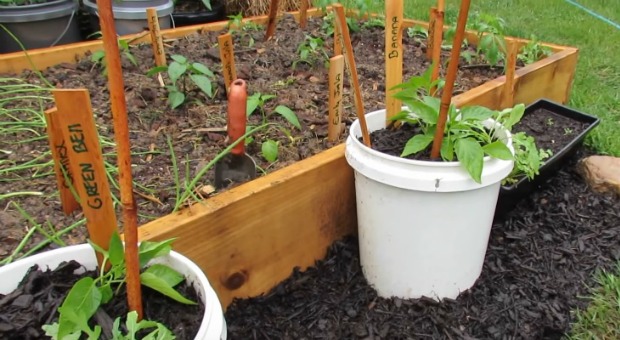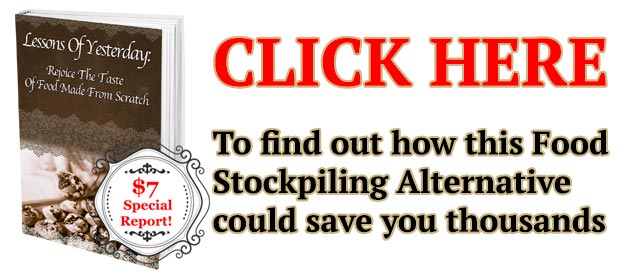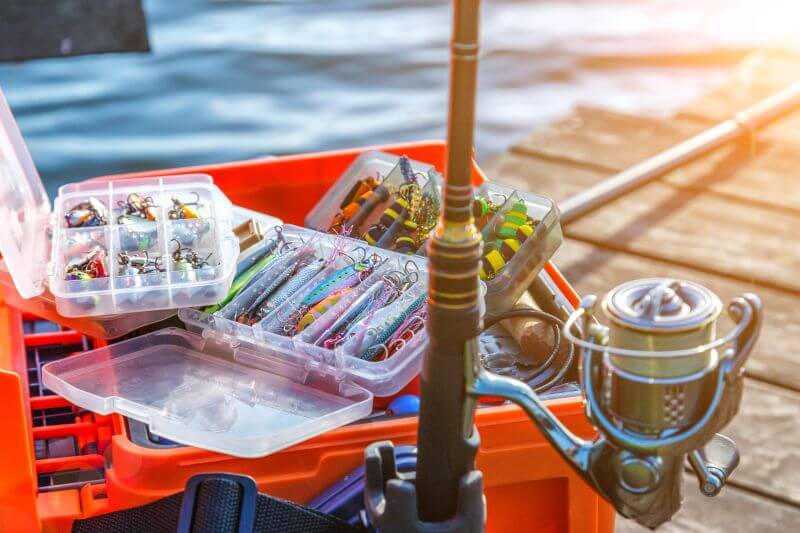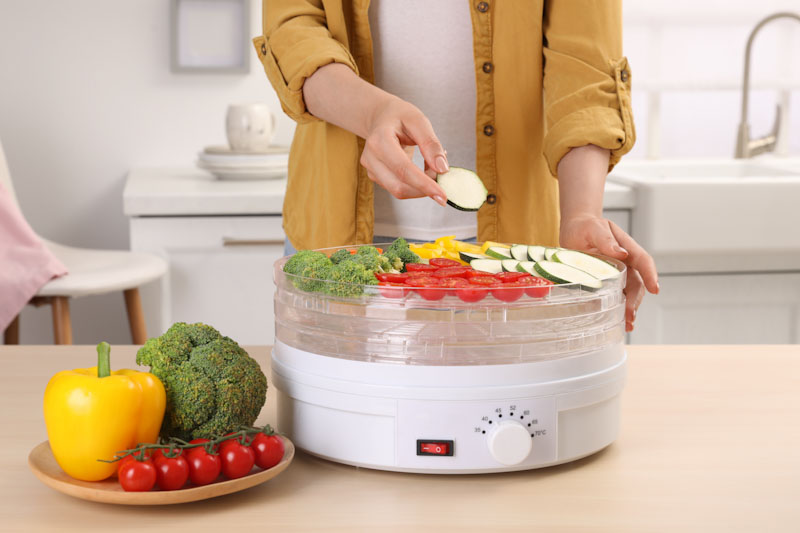There’s nothing better for you than fresh, homegrown fruits, herbs, and vegetables, but not all of us have the luxury of being able to plant a traditional garden. But did you know that you can get great yields on many types of produce?
Today we’re going to take a look at the best vegetables to grow in buckets, so that no matter where you live, you can eat well.
Growing in buckets enables people with limited space to grow their own food. Even if you have the land, buckets still make growing easier if you have a hard time getting up and down to weed the garden, take care of the plants, and pick the veggies. Or, if you’re simply too busy to dedicate the time it takes to care for a traditional garden.
If you’re using buckets, don’t forget to poke a few drainage holes in the bottom. After you’ve poked the holes, use some natural filters so you won’t lose the dirt. Put a layer of rocks, then a layer of sand if you want, then your soil. Don’t use regular dirt because it will likely compact and impair growth. Instead, use an equal mix of ripe compost, potting soil, and peat moss.
Do a little research on what your plants need so that you know to make the soil more or less acidic.
If you live in a cold climate, it’s a good idea to plant seedlings for plants that require extra time. This includes just about every plant except for green onions, shallots, carrots, potatoes, and radishes, and plants that are grown from bulbs. Of course, you always have the option of moving the buckets inside if it gets too cold too early.
Finally, you may look at the yield you’re getting per bucket and think, “Wow. That doesn’t sound like much for the amount of space I’m using. There’s a lot of soil left underneath that plant that isn’t being used.” You’re absolutely right. If you want to maximize that space instead of wasting it, consider growing plants out the bottom, too. Many plants grow well upside down.
These lessons of yesterday will teach you the basic skills you need for survival cooking!
Potatoes
Whether you like plain old spuds or prefer sweet potatoes or yams (yes, there is a huge nutritional difference), potatoes are a great bucket crop. Potatoes are hardy, grow in virtually any soil, and are grown underground, so they’re tolerant to weather changes. They’re also simple to prepare.
The key to getting a good potato yield is to grow them in a nitrogen-rich environment. Potatoes also self-perpetuate, so you’ll never run out.
Hint – grow clover on top of your potato bucket, or on the topsoil of any plant that needs lots of nitrogen, because clover pulls nitrogen out of the air and distributes it through its root system and down into the soil.
All you have to do to plant regular potatoes in a bucket is let the “eyes” or little roots grow from it, cut the potato into sections so that each section has an eye, and plant it. Plant the equivalent of one whole, large potato per 3-gallon of bucket, and 2 potatoes to a 5-gallon bucket.
You don’t even really HAVE to cut it into pieces. I just do because it’s how I was raised with a traditional garden. Old habits.
Tomatoes
Tomatoes grow fabulously in buckets; just remember that you’ll still have to stake them to something. This can be as easy as sticking a stake right in the bucket with it. No problem.
Cherry or bush tomatoes work the best and you shouldn’t plant more than one per bucket. You can pull tomatoes off in a 3-gallon bucket as long as you’ve got something besides just a stake in the bucket to stake them to, so that the weight will be supported.
Video first seen on ROCKNTV1.
Cucumbers/Squash
Any type of cucumbers or squash grow well in buckets. As a matter of fact, I have a little better luck with the buckets because it’s easier for me to find the vegetable. Often when I planted them in a regular garden, I’d lose a few in the foliage.
Plant one plant per bucket.
Peppers
These are nice to grow right on the porch as ornamentals. For that matter, so are cucumbers and squash because of the nice flowers. If you’re growing colorful peppers such as banana peppers or chilies, they brighten up the porch, too.
Interesting pepper fact that many people don’t know:
The only difference between green, red, orange, and yellow sweet peppers is the time they spend on the vine. Green ones are picked first, then if they’re left alone, they turn yellow, orange, then red. Nutritional values vary widely among the colors, though.
Plant two peppers per 5-gallon bucket.
Video first seen on Gary Pilarchik.
Beans
Bush beans grow best. Plant 1 bush per bucket.
Carrots/Radishes
Plant 10 per bucket. You can get away with using a smaller bucket or planter for these. Just make sure that the soil is at least a foot deep.
Onions/Garlic
Green onions, shallots, and any type of larger onion all grow wonderfully in buckets. For green onions and shallots, you can use a shallow bucket or window box as long as the soil is at least 6 inches deep. Just sprinkle a tablespoon or so of seeds evenly across the top of the bucket and cover with 1/4-1/2 inch of soil. For large onions and garlic, plant 4-5 per 5-gallon bucket.
Beets
Plant 4-5 per bucket.
Eggplant
Plant 2 plants per bucket because each plant requires 12-14 inches of growing space. You may be able to get away with 3. They’re good as ornamentals, too. Eggplants can be a bit finicky to grow because they require adequate water, good drainage, and pollination. Nothing is more frustrating than growing a plant then watching the flowers fall off without bearing fruit.
For your soil, use half sand and half soil/compost. Make sure they get at least two inches of water per week – more if you live in a hot climate. It’s a good idea to give them all of this water at once so that the water reaches the roots. Test your soil between waterings to make sure that it doesn’t dry out. You don’t want it too wet, but it should be moist.
Since they’re wind-pollinated, you may have a problem with adequate pollination. If you’re worried about this, it’s easy to pollinate them yourself. Just take a little paintbrush and run it around the inside of each flower.
They’ll also need a support system just like tomatoes do.
Broccoli, Cauliflower, Cabbage
These are great vegetables to plant in a bucket and you can grow 2-3 plants per bucket. Broccoli and red cabbage in particular are packed with nutrients.
Herbs
All herbs grow well in buckets, and you don’t need to use a full five-gallon bucket, either – they only need about 6 inches of soil to grow well. How many you can plant per container depends upon the herb, so pay attention to planting directions. You can even easily and successfully grow herbs inside.
Growing plants in buckets is a great method for several different reasons. From a prepper’s perspective, perhaps one of the biggest advantages is portability. If you have to bug out, you can take your food with you.
Since nearly all plants have seeds, you’re basically leaving with a food supply that will self-perpetuate, so it’s best to use heirloom seeds to ensure consistent growth and quality. I can’t overstate how important it is to choose the correct seeds for your needs.
Do you wonder what are the secrets that helped our grandparent survive during harsh times?
Click the banner bellow and uncover them!
This article has been written by Theresa Crouse for Survivopedia.










Crystal Hayward | March 28, 2017
|
I tried growing tomatoes upside down and they didn’t do anything. I’ve planted cucumbers in those tubs you put in our yard for ornamentals they did great in it.I even use old ice chest they have a drain had bell peppers (some call them sweet peppers) for several years they kept producing for a long time.
Pingback:Apartment Homesteading? Yes, You Can | Survivopedia | June 16, 2017
|
Pingback:Top 10 Easiest Vegetables For New Gardeners | Survivopedia | August 11, 2017
|
jason Smith | January 3, 2018
|
My pick is squash, cucumbers, and tomatoes. They do great in a bucket with a drain hole. Use your food scraps as fertilizer moderately. I always have a good harvest. Just be sure to keep them water since the bucket is their only water source.
For a great knife for your bug out bag, visit the link below.
https://knifearmory.ecrater.com/
jacksson | May 20, 2020
|
I use weed block material to cover up my holes in the bottom of the container; they keep the soil in and allow the water to flow out the holes. Works fine; I have been gardening in buckets for about 12 years and they use them along a chain-link fence with drippers for each pot; on the other side of the fence I put up 4 x 8-foot lattice panels from the big block store to give places for pole beans and other climbers to go. Outside the fence, I have planters made out of scrap lumber witch grow climbers that like less sun; it gets will over 100 many days of the summer here in the Central California foothills. I have found that white buckets last the longest with some I have now got in their last year at age 12.
jacksson | May 20, 2020
|
Please ignore my typos, my 80 plus years does not keep me as sharply tuned as I used to be. lol